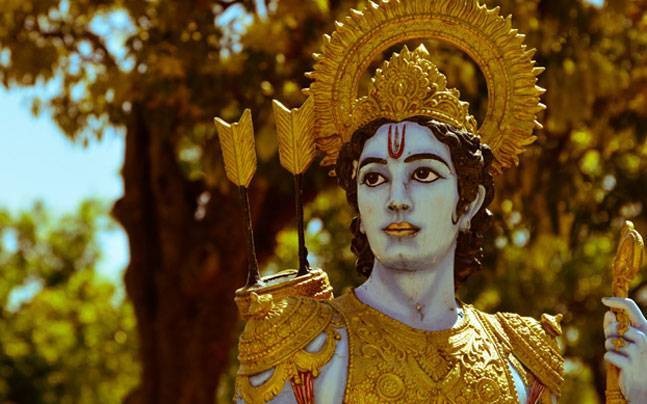Geet Ramayan, composed by Marathi poet, G. D Madgulkar and sung by Sudhir Phadke enjoys a special place in Marathi literature. It is composed of 56 songs that chronicle the epic Ramayana. Critically acclaimed, Geet Ramayan earned G. D Madgulkar the title of ‘Adhunik Valmiki’ for the series which captured the imagination of the masses in 1955-56. The second song in the series captures the glory of the city of Ayodhya. It says
‘सरयू तीरावरी अयोध्या मनुनिर्मित नगरी…
(On the banks of Sarayu, is Ayodhya, built by Manu)
त्या नगरीच्या विशालतेवर, उभ्या राहिल्या वास्तू सुंदर
मधुन वाहती मार्ग समांतर, रथ, वाजी, गज, पथिक चालती, नटुनी त्यांच्यावरी
(Beautiful edifices, mirroring the magnanimity of the city, with paved roads having adorned chariots, horses, elephants, musical troupes walking over them)
घराघरावर रत्नतोरणे, अवती भवती रम्य उपवने
त्यांत रंगती नृत्य गायने, मृदंग वीणा नित्य नादती, अलका नगरीपरी’
(Every house decorated with bejeweled ‘toran’, beautiful gardens full of the sounds of dancing, mridangam, veena…surpassing Indra’s Alkapuri)
Descriptions of Ayodhya, literally meaning the Unconquerable, in ancient texts are even more evocative. Maharishi Valmiki’s narration of Ayodhya is that of a city of abundance, wealth, culture and tranquility. It makes one feel like a citizen of Ayodhya of yore and firmly establishes Ayodhya as the epicentre of Indian civilization. Time however has not been kind to Ayodhya. From being the holy land which had been blessed by Lord Ram’s footsteps, Ayodhya fell into decline by the medieval era. The region around Ayodhya fell to Muslim marauders who choked the thriving pilgrimage to the town by taxing pilgrims and temples. The temple at the site of Lord Ram’s birth itself was razed and a Babri Masjid was built in its place. The advent of British power changed the power equation between Muslims and Hindus, who became more assertive of their rights. An attempt was made to reclaim the Ram temple way back in the 19th century but got mired in litigation. In the 1980s and early 90s, Ram Janmabhoomi Movement was revived and the Babri Masjid felled by zealous crowds of Kar Sevaks. Unfortunately, the violence and rioting that accompanied the movement, only tainted the image of Ayodhya. Far from being the center of Indian civilization, Ayodhya, scarred by invasions, conquests and now rioting, beat a retreat.
Today, a makeshift tent marks the spot where Lord Ram was born. Onerous security arrangements have driven away most of the pilgrims, while the few who reach Ayodhya are greeted by the sight of a sleepy, derelict town, lacking basic infrastructure and amenities.
Fortunately, all of this is set to stage. If all goes according to plan, Ayodhya shall soon reclaim its rightful place as India’s cultural nucleus. Unlike other governments that have been embarrassed by Ayodhya’s association to India’s Hindu past and have actively and passively disregarded its development, Yogi Adityanath and his administration are going all out to ensure that the ancient town becomes an exemplar for respect for tradition coupled with development. In spite of lack of amenities and infrastructure, the piety of Lord Ram’s devotees has ensured that Ayodhya has stayed firmly on Uttar Pradesh’s religious tourism map. Yogi Adityanath government now intends to capitalize on the town’s tourism potential and inject it with a dose of development.
To begin with, Yogi Adityanath visited the temple town in March, shortly after his elevation to the CM’s post. He became the first CM to do so since 2002. Not only did he offer prayers at the Ram Janmabhoomi site, he performed rituals at Sarayu river with a promise to beautify the ghats and hold a grand Sarayu Mahotsav. Now, on the eve of Diwali, Yogi Adityanath and his ministers are expected to descend on to Ayodhya to hold grand Diwali celebrations, including the lighting of 1.71 lakh diyas and several cultural programs. And to top it all, the state government has decided to build a grand statue of Lord Ram on the banks of River Sarayu. While this proposal is only in the draft stage, it has already rankled our liberals and intellectuals. The usual arguments of statue vs infrastructure, statue vs education, statue vs health have begun to do the rounds.
Yogi government’s decision to impart extra focus to Ayodhya stems from two reasons.
One is obviously the government’s stated cultural agenda whereby the government has committed itself to reinvigorating UP’s cultural sites and deal with the years of damage done by Samajwadi and BSP regime who treated Hindu cultural sites with apathy to pander to their minority votebanks. And Secondly, Yogi government seems to be looking at the economic aspects of developing Ayodhya as a prime tourist destination. Already, Ayodhya is the second most prominent tourist destination in the state. UP is due to host the Ardh Kumbh Mela in 2019, when it would host large number of pilgrims and devotees. By developing infrastructure and tourist spots in Ayodhya, it aims to offer new, lucrative tourist destinations to pilgrims and devotees, maximizing revenues. Were Yogi government to execute this with clinical precision, there are chances that it would recover its investment costs in time for the 2019 tourist season to begin. While there is obviously an element of cultural nationalism in all this, there is no doubt that it is backed by solid economic considerations.
A grand Ram statue would serve as an attractive tourist destination for pilgrims.
Not only the grand Ram statue, there are plans to have a Ram Katha gallery, and an auditorium in Digamber Akhara. These plans, among others, add up to Yogi’s determination to have a ‘Navya Ayodhya’ in place to replace the old, dusty and derelict Ayodhya that for years has stood as a symbol of India’s cultural impoverishment.
